What Are Chakras? The concept of Chakras is closely attached to energy. The energy within us, also which is manifested in the whole universe.
The Universe is referred to as a system of many elements acting or fused together to function as a unit.
According to Tantric Buddhism and Hinduism, just like the Universe, Our body itself is believed to be made of five core elements Air, Space, Earth, Water, and Fire.
Concept of the Human Body
Similar to how the world is composed of five different elements, our body is made up of many interconnected little systems of cells that function in unison. These energies cause ongoing alterations to take place in our bodies.
Our inner and outward systems are both established and maintained by various energies flowing continuously through us. These energies have a crucial role in influencing our nature, conscience, behavior, mood, and overall well-being.
Speaking for energies, many questions arise in the mind including, what is the source of these energies in our body? What makes up the definitive but vast system of human mechanisms?
The Yogic method now makes it possible for us to identify the correct energy sources, their functions, and their meanings through Chakras.
What Are Chakras
Prana – The Life‘ in certain major parts of our body constantly spinning to keep us alive and active. The spinning or rotating nature of Prana made these parts of the body, ‘centers of energy also known as Chakras.
The word “Chakra” (in Sanskrit, “Cakra”) means “Wheel” or “Disc,” and it gets its name from the way Prana rotates as it passes through it.
In a nutshell, chakras are the body’s Nadi junctions. Anodea Judith wrote in her book, “The Wheels of Life,” “These Nadis converging at particular spots in our body form a junction we know as Chakra.”
Where Nadis are the pathways of ‘Prana – life force’, Chakras are the distributor and purifier of the Prana.
Indeed, Nadis always meet at junction points in a triangular shape but even after that these points are called Chakra, not Trikon (Triangular). The reason behind it is – Prana within Nadis. Prana introduces a motion at the junction points and motion (energy) always radiates in the circular form. This is how Chakra’s formation takes place.
3 States of Chakras
Each chakra has three states of activity, which can be used to understand how they function. Each Chakra’s rate of Prana rotation determines its state at any given time.
- A chakra is said to be in an overactive state when the rate at which Prana rotates exceeds that of a normal chakra. You will experience an excessive energy flow through the corresponding organs of the hyperactive Chakra in this state.
- When Prana spins normally, energy does not flow into any organs excessively or insufficiently, which is the balanced state of a chakra.
- The underactive state of a chakra occurs when Prana rotates at a slower rate than usual due to inattention or specific physical activities.
Imbalanced or blocked chakras occur when there is an improper energy flow through them in both hyperactive and underactive states.
If chakras become blocked, it may result in disease and other problems that are manifestly physical or behavioral.
History of Chakras
Chakras were initially recognized as psychic centers of consciousness in the Upanishads circa 600 BC, which is when the word’s historical significance began to take shape. Around 200 BC, Patanjali’s Yoga Sutras followed a similar approach.
According to the etymology, Tantric Buddhism and Hinduism are where the idea of chakras (also known as the “Wheels of Life”) initially emerged. It was first devised and introduced in the Vedas, which were introduced by Patanjali’s Yoga Sutras and the Upanishads.
According to each person’s perception of Kundalini, a different number of Chakras have been discovered (the energy that is unleashed in creation, and lies coiled and sleeping at the base of the spine). Later, a similar philosophy was developed in Sufism.
The idea of a chakra as an energy center originated in India and was transmitted to China, where it was assimilated and harmonized with the country’s conceptions of energy flow (Qi energy), which replaced Kundalini.
The idea of a chakra as an energy center originated in India and was transmitted to China, where it was assimilated and harmonized with the country’s conceptions of energy flow (Qi energy), which replaced Kundalini.
The idea of chakras is still widely used in the Western New Age Movement today. The Modern Age movements have enhanced awareness of chakras in the West.
What Are Chakras How Many Chakras Are There?
Yoga formulations typically describe seven chakras, says Dr. Georg Feuerstein in his book Yoga Encyclopedia although additional chakras are also described in some systems.
Apart from the yogic system, prominently there are 114 Chakras with 72,000 Nadis lying in the body.
114 Chakras can be divided in the following way.
- The physical structure of the body contains 112 chakras, and the remaining 2 are located in the outer plane.
- 86 of the 114 chakras, commonly known as acupuncture points on the body, are micro chakras.
- Currently, there are 28 chakras in total, 21 of which are minor chakras that cooperate with the major chakras and are dispersed throughout the body.
- The final seven are referred to as major chakras; five are located along the spinal column, one is located on the forehead, and one is located over the head (outside of the body).
- Each chakra is designated by a particular hue and has a unique function, symbol, and energy frequency. Each one is linked to various bodily glands and organs in order to channel energy (in the form of Prana) through “Nadis.”
7 What Are Chakras
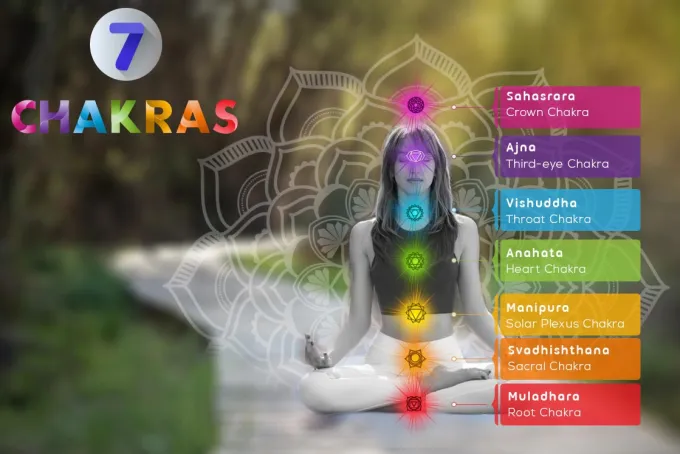
Ida (on the left side), Pingala (on the right side), and Sushumna Nadi are the three primary Nadis in the subtle body along the spinal cord (Central).
7 Hchakras are the converging point of Ida and Pingala Nadis which are the source of Sun and Moon energy in the body. Joining sun and moon energy at these places produces a powerful vortex of energy; hence it’s called ‘7 centers of energy (7 chakras).
Each chakra has a distinct significance and function that can be determined by its special qualities.
Characteristics of 7 major chakras
Some significant points are used in the description. these are what they are.
Location of Chakras: The location of a chakra represents the energy accumulation from massive nerves centered at a specific position. These positions are 5 along the spine and the rest 2 on the forehead and above the forehead.
The element of Chakras: 5 elements of the physical body represents the first 5 chakras. The last 2 chakras (Ajna and Sahasrara) respectively representation of the mental body and consciousness.
Number of Petals in Chakras: Chakra is also called Lotus and there is a specific number of petals considered for each Lotus or Chakra.
These lotus petals signify the number of Nadis meeting at the junction point. The higher the number of petals of a lotus, the higher the energy associated with a specific chakra.
Sound or Mantra of Chakras: All 7 Chakras stimulate corresponding to a particular set of frequencies. The vibrations of the corresponding chakra are resonated through each Beej mantra. Beej mantra with daily meditation balances the energy of each chakra
Color of Chakras: Energy emitted through each chakra gives a specific color, called ‘chakra’s color’. This emitted color through each chakra usually indicates the emotions and physical & spiritual state of a human being.
Now that you are familiar with the fundamentals of chakras, let’s talk in detail about how each chakra relates to your physical, mental, and every other part of your life.
We will talk about the following aspects of each chakra.
- location and element of chakras
- Chakra Symbol, Color, and Mantra
- Balanced and unbalanced behavior Chakras
- Unblocking of obstructed chakras
1st Chakra – The Root Chakra – Muladhara
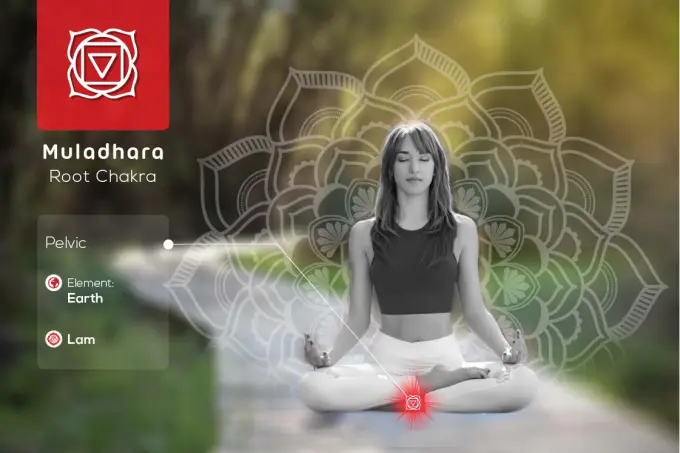
The Sanskrit phrase Muladhara, which translates to “Basic or Root,” and “Support,” respectively, highlights the significance of the first chakra.
The first chakra is in charge of providing for a person’s daily necessities of food, shelter, and survival. It determines our capacity for survival and stability.
The root chakra’s four petals represent the four subtle Nadis that meet at the base of the spine.
Qualities of Root Chakra
The Root Chakra introduces you to traits like:
- Your capacity for perception and smell
- Feeling of safety
- Your direct physical participation in the outside environment
- You may maintain your grounding by being present in the world.
Read More: Root Chakra Characteristics
Signs of Balanced Root Chakra
In a state of the balanced root chakra
- Your vitality and sense of responsibility would increase.
- You’ll feel more secure since you’re connected to and grounded in the earth.
- When attempting to meet survival needs, try to be happier
When root Chakra is overactive,
- You are more prone to develop into a scared person.
- Your chances of developing issues with your spine, kidneys, prostate, and suprarenal glands increasing
- Too possessive a mindset
- Anxiety becomes more prevalent as fear and unfulfilled basic requirements for survival go hand in hand.
When the root chakra is overactive, people should try to balance it by diverting the surplus energy there to other chakras that are underactive.
To balance an overactive root chakra
- Bring yourself forward to act of kindness,
- Connecting yourself with earthly elements,
- Channelize your energy into works like gardening, planting, or walking.
Read More: A Quick Guide to Balance Root Chakra
Signs of Underactive Root Chakra
When the Root Chakra is insufficient, it might cause you to
- Feel homelessness (insecurity),
- Depression and thus not being able to be grounded,
- Lack of strength for any work,
- The misunderstanding even can make you feel like a victim.
How to Energize Underactive Root Chakra –
There are three methods for reviving your weak root chakra:
- By repeating the Bija Mantra, the seed sound, Lam
- By consuming root and red-colored veggies including radishes, carrots, potatoes, tomatoes, cherries, and strawberries, among others
- By putting on jewelry made of stones or gems that activate the root chakra, such as bloodstone, red jasper, and black tourmaline.
Read More: Muladhara Chakra Comprehensive Guide
2nd Chakra – The Sacral Chakra – Svadhishthana
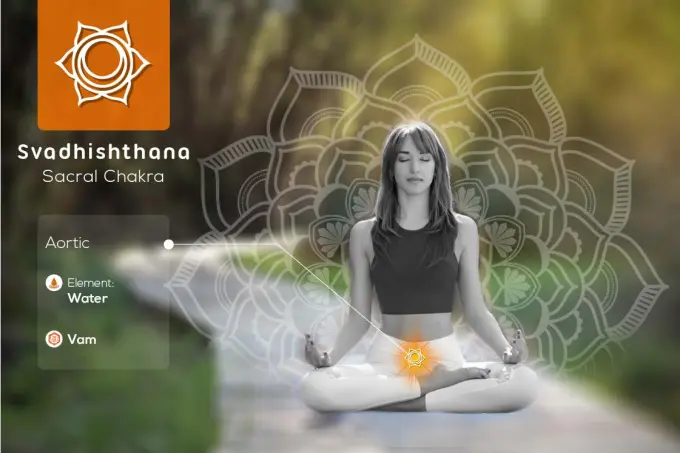
The second of the seven chakras is called the Svadhishthana Chakra, and it extends to the middle of the abdomen from below.
Svadhishthana = Sva (One’s Own) + Adhishthana (Place). Additionally, the word “Sad” can indicate “Activity of taking pleasure” in specific cases.
The final definition of the word Svadhishthana is the realization of your identity in relation to the world around you as a son, brother, friend, father, etc.
A silver crescent moon with its tip pointing up is enclosed in an orange circle as the sacral chakra symbol. The water element of the sacral chakra is symbolized by the silver crescent moon. Six lotus petals surround the diameter of the circle, which is spelled with a special Sanskrit phrase.
Qualities of Sacral Chakra
Sacral Chakra characteristics linked to:
- Your capacity for judgment is influenced by intellect when making decisions.
- Another sacral chakra characteristic is a sense of sexual energy and expression.
- Your intuitional and creativity.
Sign of Balanced Sacral Chakra
Depression is literally a closing down of this chakra’s energy says Ambika Wauters in her book “Healing with Energy of Chakras”
The indicators listed below can help you determine if your sacral chakra is in balance.
- You can fully enjoy all of life’s pleasures with a balanced sacral chakra without becoming dependent on or overindulging in them.
- You are stronger at keeping relationships with those close to you and more modest.
- Since you see the world and yourself from the same perspective, relationships become cordial and joyful.
Signs of Overactive Sacral Chakra
When the sacral chakra is overloaded with energy,
- You have a higher chance of developing a manipulative personality.
- Obesity, hormonal abnormalities, and restlessness are examples of physical symptoms.
- You develop a dependency on pleasures when your second chakra is overactive.
- A person develops lust and a need to be in control of their actions.
How to Balance Sacral Chakra
2nd Overactive Chakra must be balanced.
- Its hyperactive energy should be directed onto surrounding chakras. Withdraw from addictive pleasure sources so that you can become more grounded in the real world.
- Every activity should be evaluated to see if it is good or nourishing for you; if not, it should be avoided.
Signs of Underactive Sacral Chakra
When there is a lack of energy in the sacral chakra, you will begin to experience the following symptoms.
- Observing the practical guidelines while overlooking the enjoyment of the creative process
- You’ll experience low back discomfort, erectile problems, and a loss of taste.
- You experience psychological instability, problems with trust, and a lack of passion.
How to Energize Underactive Sacral Chakra –
- The practices listed below are beneficial for restoring the sacral chakra’s energetic level.
- Meditating while repeatedly reciting the seed sound “Vam”.
- One strategy to balance the depleted amount of energy is to keep yourself near water and water features (since the element of the Sacral Chakra is water).
- Your sacral chakra energy can be raised by wearing gemstones like orange aventurine, orange carnelian, citrine, orange calcite, and coral calcite.
3rd Chakra – The Solar Plexus Chakra – Manipura
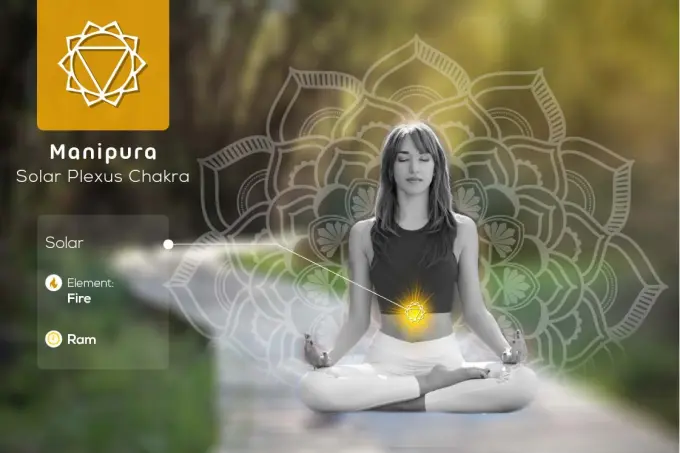
Manipura, which is located directly in the middle of the body, represents the third spoke of the Wheel of Life. Since it is positioned just above the navel, it is also connected to your digestive system.
The term “Manipura” refers to the body’s “Lustrous Gem,” which is where it is found. It bears a symbol of a red triangle falling inside a circle that stands for personal identity and willpower.
The Solar Plexus Chakra’s ten Pranas, or vibrations, are represented by the number 10 in the petals. Its color is yellow and compares your brightness to the sun. The vivid yellow color represents the enthusiasm you have for advancing both personally and professionally.
Its main component is Fire, which is associated with the pancreas, stomach, liver, and gall bladder.
Qualities of Solar Plexus Chakra
The Solar Plexus Chakra is linked to the following characteristics:
- It is where Prana and Apana come together (the second life force of a total of five i.e., Prana, Apana, Vyana, Udana, and Samana).
- Your awareness and determination.
- It has to do with your ego, your use of willpower, and your ability to control yourself.
- The body’s distribution of nourishing substances.
Signs of Balanced Solar Plexus Chakra
The following states indicate that your third Wheel is balanced.
- When you are more committed and assured in yourself in all you do.
- Your desire to learn the truth about your life increases.
- Your decision-making, self-control, and confidence in your goal and actions increase.
Signs of Overactive Solar Plexus Chakra
In the overactive state of Solar Plexus Chakra:
- You frequently try to exert control over other people or your environment by acting in an overly authoritative manner.
- You make an effort to make more rational conjectures.
- Making plans and placing strict restrictions on oneself are two instances of the hyperactive Solar Plexus Chakra.
One of the most frequent problems brought on by the stimulated Manipura Chakra is getting irritated about trivial things.
How to Balance Solar Plexus Chakra –
You must: in order to ground the overactive Solar Plexus Chakra.
- Give people a piece of yourself by being loving and compassionate.
- Consider others’ needs and feelings as well as your own.
- Give yourself additional time to reflect on and evaluate your actions.
- You must act in a way that does not negatively impact those around you.
Signs of Underactive Solar Plexus Chakra
When your Solar Plexus Chakra is in a weak state, you are susceptible to depression.
- You lose your ability to make decisions because you lose confidence in this stage.
- You become more reticent and find it difficult to express your worries.
- You become less capable of appreciating your own worth, more obedient, and less willing to appreciate yourself.
How to Energize Underactive Solar Plexus Chakra –
- Chanting the seed sound “Ram,” which is a part of the Bija Mantra for the Solar Plexus Chakra, will assist in re-energize this Wheel.
- The underactive Solar Plexus Chakra is stimulated by meals that are yellow in color. You can add turmeric to your diet and consume foods that are yellow in color. Rice, flax seeds, and cereals can all help your Manipura Chakra.
- The crystals amber, citrine, lemon quartz, yellow jasper, and yellow tourmaline activate your solar plexus chakra.
4th Chakra – The Heart Chakra – Anahata
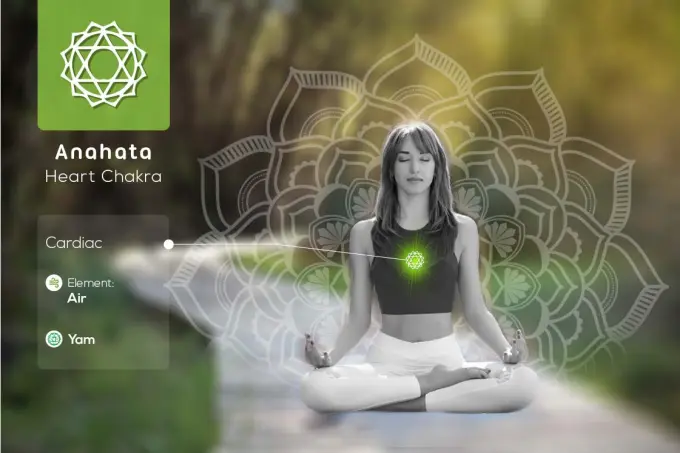
The fourth of the seven major chakras, which symbolizes the free movement of energy like air, is represented by the color green, and as such, the air is its element.
The symbol of the heart chakra is denoted with 12 Lotus Petals
The Lungs, Thymus, and Liver are all included in the Heart Chakra, which is located around the heart. This Chakra is linked to blood circulation because it is located directly above the heart.
Qualities of Heart Chakra
- The capacity to retain human connections
- Your awareness and insight integration are centered there.
- Through the Heart chakra, you may select how you treat others and yourself.
Read More: Heart Chakra Characteristics
Sign of Balanced Heart Chakra
- As one does for others, one tends to feel love and compassion for oneself.
- You show everyone you care about them in an unwaveringly loving, altruistic, compassionate, and devoted manner.
- No matter how stressful or sparse things are around you, you still have compassion for other people.
Signs of Overactive Heart Chakra
If any of the following apply, you may have had an overactive heart chakra:
- You express yourself too strongly.
- Become overly critical and envious.
- Having too much affection for something or someone, or being unable to control your emotions.
- You’re going through a careful connection process.
- Your emotions are controlling you.
- You automatically say yes without even weighing the benefits and drawbacks.
How to Balance Heart Chakra
You can achieve balance in your heart chakra by:
- Giving oneself a treat by going outside.
- The first step in restoring the balance of the Anahata Chakra is learning to love and accept yourself.
- Learn to say no when it’s appropriate. It is occasionally the finest method to listen to oneself.
- Even when you’re at your worst, show others kindness and compassion.
Read More: A Quick Guide to Balance Heart Chakra
Signs of Underactive Heart Chakra
The heart chakra is underactive when you experience:
- Lack of emotions for others.
- You are hard to be kind to others or compassionate.
- It is hard to get involved in love relationships for you.
How to Energize Underactive Heart Chakra
These straightforward actions will help you increase the energy of your underactive Heart chakra.
- Since green is the primary color, eat green foods, go for walks in green spaces, and generally surround yourself with this hue.
- To strengthen your heart chakra when meditating, practice saying the chant “Yum.”
- Wear gemstones that strengthen your heart chakras, such as Chrysoprase, Epidote, and Malachite (which dispels negativity and calms the energy level of the heart chakra) (to bring more joy and positivity).
Read More: Anahata Chakra Comprehensive Guide
5th Chakra – The Throat Chakra – Vishuddha
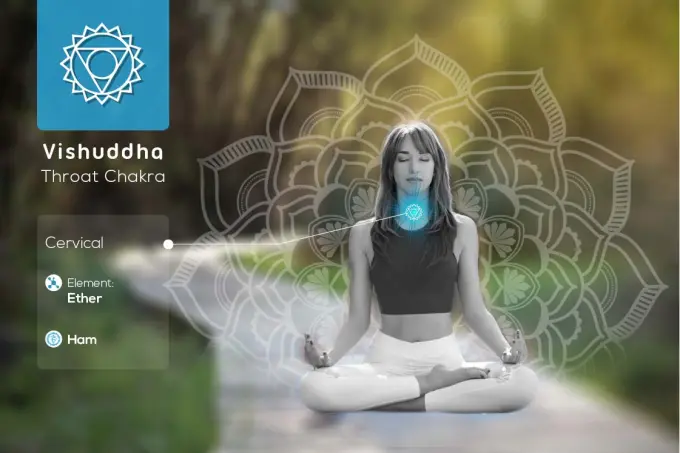
The fifth chakra, or Vishuddha, stands for purity and clarity.
The fifth chakra also referred to as the throat chakra, is located on the throat navel in the middle of the neck. The Throat Chakra, which is situated close to the vocal cords, represents the capacity to hear and communicate the truth.
Throat Chakra symbol symbolizes using a circle inside a descending triangle with a crescent moon that defines your pure instinct and communication ability. It is identified by the color blue and has 16 Lotus petals.
The other names by which throat Chakra is known are KanthPadma and ShodsashDala.
Qualities of Throat Chakra
- Your capacity for speaking the truth and hearing the truth
- Your capacity for creativity and self-awareness
- Defines internal and non-internal communication in addition to verbal and non-verbal exchanges
Read More: Throat Chakra Characteristics
Sign of Balanced Throat Chakra
- Your mental processes and communication are more exact.
- Your artistic side in the world is more clearly displayed.
- Your motivation is supported.
Signs of Overactive Throat Chakra
- Speech control slipping away
- Your language seems cruel.
- Words or ideas that are manipulative begin to enter your head.
How to Balance Throat Chakra
- Practicing listening more and speaking less
- Inculcating Patience and thinking about what you are to talk about and to whom
- Keeping close to the blue sky or ocean, since the blue color is the indicator of Throat Chakra
Read More: A Quick Guide to Balance Throat Chakra
Signs of Underactive Throat Chakra
- A slurry and less confident speech.
- Lack of ability to express yourself.
- Less communication with the people.
- Feeling scared while expressing your views.
How to Energize Underactive Throat Chakra –
Try these easy techniques to strengthen the weak Throat Chakra:
- Increase your artistic and creative involvement.
- While meditating, repeatedly chant the Bija Mantra (Seed Sound)-Hum/Ham.
- Wear blue gemstones and stones, such as azurite, Lapis, turquoise, lazuli, sodalite, and aquamarine, to assist you to raise your lower energy levels.
Read More: Vishuddha Chakra Comprehensive Guide
6th Chakra – The Third-Eye Chakra – Ajna
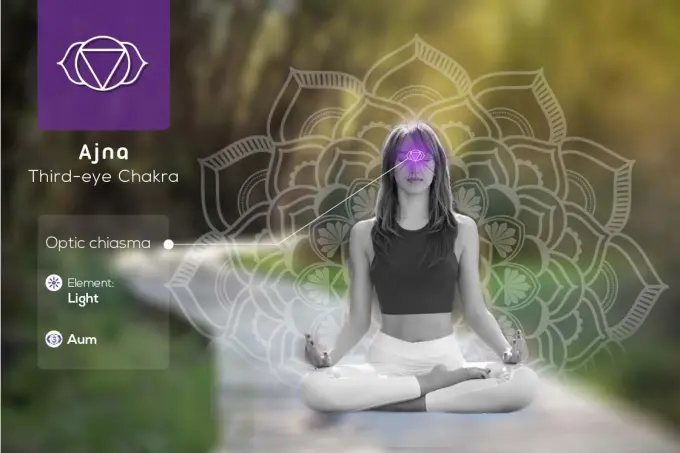
Ajna Chakra is another name for the Third-Eye Chakra, which is situated in the middle of the forehead, between the eyebrows. Due to its position, it is often referred to as the brow chakra (in the space between the eyes)
The Ajna chakra emblem consists of two petals of a lotus plant, a triangle pointing downward beneath a circle. This symbol represents the coming together of two significant nadis, concept and Pingala.
Our pituitary gland, sixth sense, spine, and lower brain are all connected to the Ajna chakra. It has an impact on how well the eyes, ears, nose, pineal glands, and extrasensory perception work.
Qualities of Third-Eye Chakra
- The capacity to understand life and death concepts through wisdom
- Using the third eye to perceive an environment that doesn’t actually exist
- Identifying patterns and connecting them to a larger picture, results in more clarity and subtlety.
Read More: Third-Eye Chakra Characteristics
Sign of Balanced Third-Eye Chakra
- Your eyes are said to reflect the Third Eye Chakra with a glitter once it is balanced.
- Your metabolism increases, your vision improves, and your upper body’s strength grows.
- Your memory gets sharper, and your capacity for calm, thoughtful thought is at its peak.
Signs of Overactive Third-Eye Chakra
The Third Eye Chakra’s overactivity has a significant impact on your psychological conduct. These consist of:
- Fantasizing more often.
- A constant or overwhelming stream of thoughts might psychologically tire you.
- In the hyper estate of the Ajna Chakra, even the simplest decisions might be difficult to make.
- The two symptoms of an overactive Ajna Chakra that people typically encounter are hallucinations and anxiety.
How to Balance Third-Eye Chakra –
- Connect to the ground in order to calm this Chakra’s overactive state.
- Working on the lower level chakras is an easy method to find a remedy to balance this situation (Heart, Throat, and Sacral).
- Get up from the decision-making chair and take a nap to allow your senses to adjust.
- Consider yourself first before passing judgment on others.
Read More: A Quick Guide to Balance Third-Eye Chakra
Signs of Underactive Third-Eye Chakra
If: This chakra is considered to be lacking in energy,
- Your ideas frequently make you feel frightened.
- Anxiety, depression, and stress are becoming commonplace problems.
- Even the most basic things and experiences are challenging to recall.
How to Energize Underactive Third-Eye Chakra –
To energize your third-eye chakra, try these:
- Put some blueberries, raspberries, grapes, Wine, and blackberries on your table and eat healthily.
- Chant often while meditating the Seed Sound “Om/Aum” connected to the Ajna Chakra.
- Wear Indigo/Blue Kyanite, Phenacite, Satyaloka Quartz, and Tanzanite, which are Third-Eye Chakra Stones, to activate the Ajna Chakra and bring it to the Vital State.
Read More: Ajna Chakra Comprehensive Guide
7th Chakra – The Crown Chakra – Sahasrara
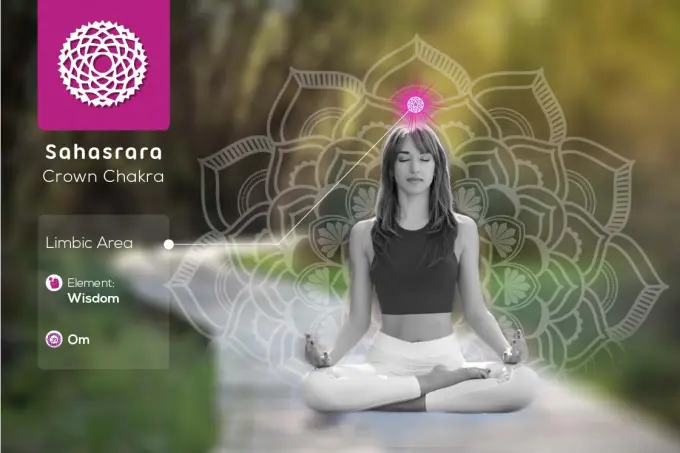
The Crown Chakra is the last and highest chakra that is located outside of the body. This chakra is also referred to as Sahasrara, which means “a Thousand Petals,” in Sanskrit.
The chakra’s violet color stands for your presence outside of your bodily ties.
All of the lower-level chakras combine with their corresponding attributes at the Crown Chakra, which is their center. It is thought that once you have mastered your lower chakras, balancing your crown would be easier.
Qualities of Crown Chakra
- Your current level of consciousness is defined by this Chakra, which is also regarded as the entrance to your divine self.
- Through harmony and unity, the energy linked to the Crown Chakra reveals the nature of the cosmos’ mystery.
- The Crown Chakra encourages you to let go of your ego and pride and to think beyond selfishness and other limitations.
Read More: Crown Chakra Characteristics
Sign of Balanced Crown Chakra
As of right now, there is no concrete proof of who has attained this energy level. Nevertheless, when your Crown Chakra is in harmony,
- The ultimate state of consciousness and enlightenment is attained.
- You experience the sweetest, most delightful connection to all living things.
- You think of everything and everyone equally, expecting nothing in return.
Signs of Overactive Crown Chakra
- Although it is stated that when the Sahasrara goes into overdrive, you can become an egomaniac, proud, and egotistical person who wants to govern.
- You are most likely to abuse your abilities and senses in this situation.
How to Balance Crown Chakra –
You must direct your energy down to the lower rungs of the energy ladder in order to quiet a hyperactive Crown Chakra.
- Consider the universal truth that everything is interconnected and that we are all composed of the same substances.
- When you realize you have everything you need to exist, live with appreciation, develop a greater capacity for trust, and use what you have to help those who are less fortunate.
- Face the sun as you leave and let the brightness shine on you.
Read More: A Quick Guide to Balance Crown Chakra
Signs of Underactive Crown Chakra
- It is common to experience the Crown Chakra in an inactive state.
- In some circumstances, the underactive condition can cause you to continue to be distant and disengaged.
- You have the smallest chance of having a spiritual connection.
- The frequency characteristics of a Crown Chakra State that are weak include loneliness and meaninglessness.
- When you are wise and knowledgeable yet refuse to impart it to others
How to Energize Underactive Crown Chakra –
Letting the ego disappear is the first step in the journey to enlightenment. (I am the same as everyone else; I am aware of and act in accordance with my aim.)
- Practice saying the Bija Mantra “Om/Aum” while in meditation to activate your underactive Crown Chakra.
- Wear Kyanite to raise the Crown Chakra’s energy level.
- Consume herbal foods like Copal, Juniper, Sage, and Myrrh to replenish your energy.
Read More: Sahasrara Chakra Comprehensive Guide
Conclusion
The battle between balance and disequilibrium never ends. The healthiest state for your mind, body, and soul is when your chakras are open and in alignment.
However, difficulties start to appear when imbalances start to show themselves. Defeated, lethargic, sad, and depressed are how you feel. It’s not always necessary to use medication to treat them. Sometimes the solution is straightforward and only calls for a little exercise.
Other times, though, it becomes important to add medical care as a complement. Whatever the issue, most issues can be resolved by allowing your chakras to open. Don’t be pessimistic and discount yoga’s benefits. To make it more valuable, learn more about it and incorporate it into your daily life.





















